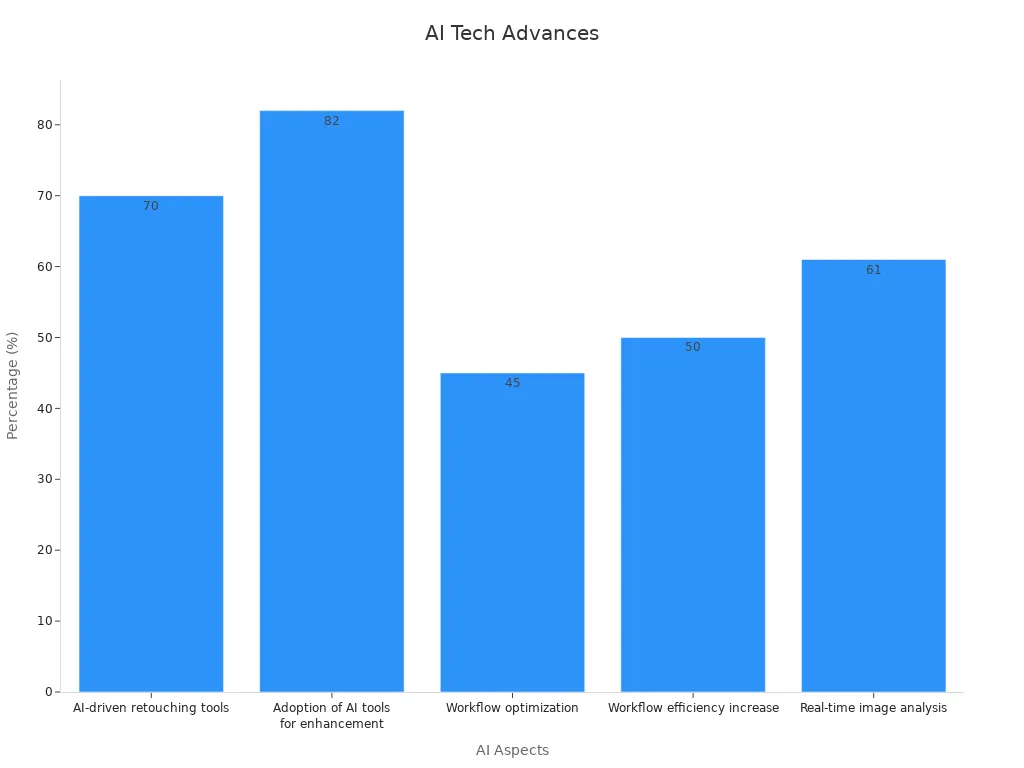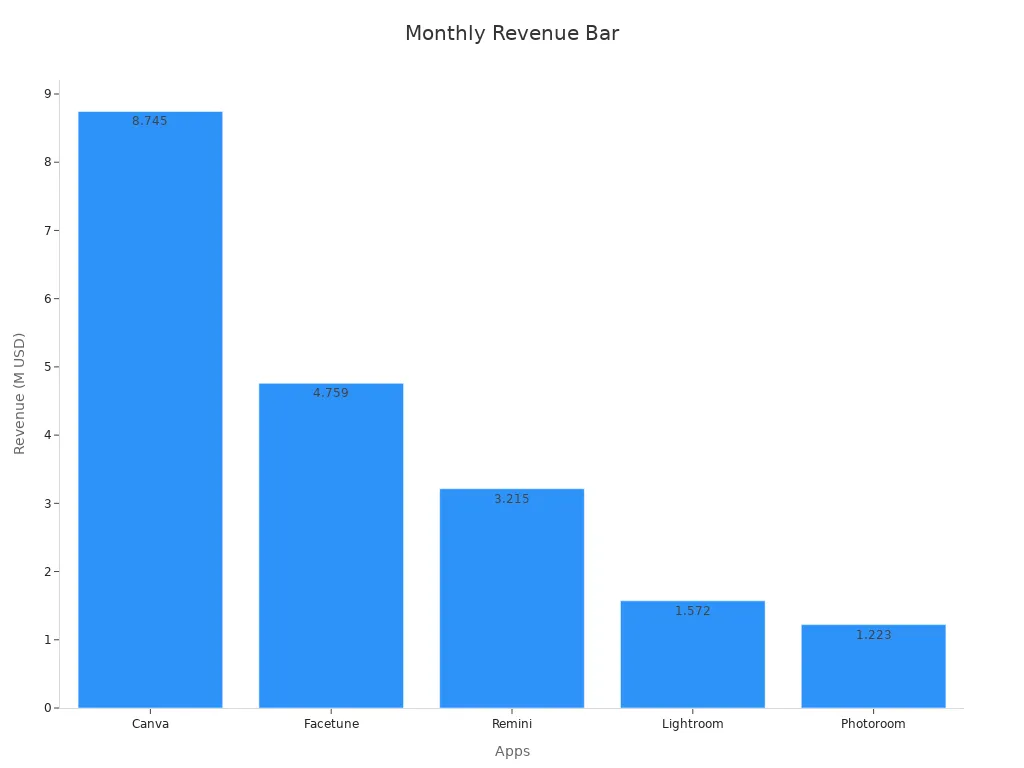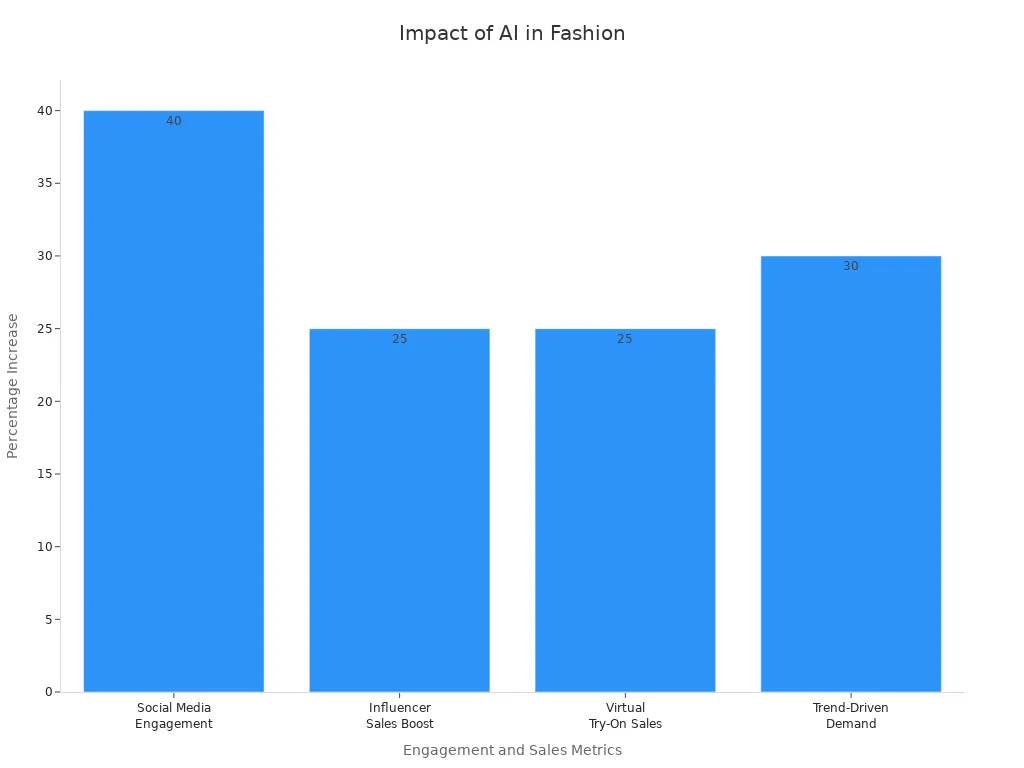
AI image editing reshapes e-commerce by making product visuals faster, smarter, and more engaging. Brands now rely on ai image editing services to keep up with the demand for fresh, high-quality images. A recent survey shows that 96% of e-commerce teams struggle with traditional image creation, while 75% of marketers already use ai in their workflows.
WeShop’s AI E-Commerce Creative Studio stands out for its ability to deliver high-quality image editing and content creation at scale. With ai powering every step, teams save time, cut costs, and boost customer engagement. Fast, scalable, and trend-driven images help e-commerce brands reach new heights in product presentation and customer connection.
Key Takeaways
- AI image editing helps e-commerce brands create high-quality product images faster and cheaper.
- Personalized images showing products on diverse models boost customer trust and increase sales.
- Localization of images to fit local cultures and languages improves customer connection and market reach.
- AI tools let brands quickly update images by swapping backgrounds and models to keep up with trends.
- Popular AI platforms offer features like virtual try-on, batch editing, and background removal to save time.
- AI image editing supports brand consistency by keeping product visuals uniform across platforms.
- Using AI to optimize images can raise conversion rates by making products more appealing and easier to buy.
- Brands should combine AI automation with human review to ensure image quality and ethical use.
E-commerce Image Needs

E-commerce brands face a growing demand for diverse and high-quality images. Shoppers want to see products from every angle, on different models, and in various settings. This need for variety goes beyond simple product shots. It shapes the way brands connect with customers and drive sales.
Personalization
Personalization stands at the heart of modern e-commerce. Brands use AI to create images that match each shopper’s preferences. For example, a customer might see a product on a model who shares their skin tone or body type. This approach helps shoppers imagine how the product will look on them. Market research shows that e-commerce relies on a wide range of product images to mimic the in-store experience. AI technologies like visual search and virtual try-on depend on detailed images to deliver personalized recommendations. These tools also help brands spot subtle differences in color or texture, making each image more relevant.
Personalization does more than just improve the shopping experience—it boosts sales. Take a look at how different strategies impact conversion rates:
| Personalization Strategy | Impact on Conversion or Revenue |
|---|---|
| Personalized product suggestions (McKinsey) | Boost revenues by 10-30% |
| Amazon AI-driven personalized listings | Drive 35% of Amazon’s revenue |
| Personalized product recommendations | Increase conversion rates by up to 288% |
| Location personalization (Hall Wines) | Increase add-to-cart rates by 55% and 80% on sister site |
| Personalized emails (Experian) | Yield 6x greater transaction rates |
| Consumer preference for relevant offers | 91% of consumers prefer brands with relevant offers |
These numbers show that personalized images and recommendations can make a big difference in e-commerce.
Localization
Localization means tailoring product images to fit the culture and language of each market. Brands that localize their images build trust and loyalty with shoppers. A CSA report found that 65% of consumers prefer content in their native language. Localized images help create a natural shopping experience and encourage customers to buy.
- Localization adapts all e-commerce content, including images, to the target market’s culture and language.
- It increases market share and revenue by connecting with international customers.
- Localized product images help brands scale faster across new markets.
- Brands gain region-specific data, which helps them optimize marketing and product offerings.
When brands use images that reflect local styles and preferences, they see higher engagement and more sales.
Fast Updates
The e-commerce world moves fast. Trends change overnight, and brands must keep their product images fresh. AI-powered image editing tools let teams update images quickly. They can swap backgrounds, change models, or adjust product details in minutes. This speed helps brands stay ahead of trends and respond to customer feedback right away. Fast updates also mean fewer delays in launching new products or campaigns. With the right tools, e-commerce brands can deliver the latest looks and keep shoppers coming back for more.
AI Image Editing Basics
Core Technologies
AI image editing has changed how brands create product images for e-commerce. The technology behind these tools uses deep learning, neural networks, and transformer models. These systems learn from huge sets of images and can generate new, realistic visuals. For example, tools like DALL-E 2 can create detailed images from just a text prompt. This makes it easy for anyone to get professional results, even without design skills.
A recent report shows how much these technologies have improved the editing process:
| Aspect of AI Image Editing | Statistic / Finding | Impact / Insight |
|---|---|---|
| AI-driven retouching tools | Reduce editing time by up to 70% | Significantly speeds up retouching, beneficial for high-volume or deadline work |
| Adoption of AI tools for enhancement | 82% of photographers use AI for image enhancement | Indicates widespread integration of AI in editing workflows |
| Workflow optimization | 45% of professional photographers use AI to streamline workflows | Shows nearly half of professionals rely on AI for efficiency gains |
| Workflow efficiency increase | AI-driven editing tools can increase efficiency by up to 50% | Demonstrates substantial productivity improvements |
| Real-time image analysis | 61% of professionals use AI for real-time feedback | AI is used actively during shooting, not just post-production |

These advances mean brands can now create high-quality product images faster and more affordably than ever before.
Workflow Steps
AI image editing tools make the process simple and efficient. Here’s how a typical workflow looks:
- Upload product images or select from a library.
- Use AI to remove the background or swap backgrounds for different settings.
- Adjust lighting, colors, and sharpness with AI-powered filters.
- Batch process multiple images for consistency.
- Download ready-to-use images for e-commerce platforms.
AI automates repetitive tasks, like background change and image recognition. This reduces manual work and speeds up the process. Businesses save time and money, while also reducing errors. AI-driven workflows help brands scale up quickly, handling large numbers of product images with ease.
Model and Background Swap
One of the most exciting features in ai image editing is the ability to swap models and backgrounds. With just a few clicks, brands can show the same product on different models or in new scenes. This helps with personalization and localization, making product images more appealing to different shoppers.
AI photo editing tools use smart algorithms to recognize clothing, skin, and product details. They keep textures and colors true to life, even when changing the background or model. This means brands can create images that match their style and target market, all while keeping a consistent look.
Here are some key benefits of using ai image editing for model and background swap:
- AI tools enhance product appeal by optimizing colors, removing imperfections, and ensuring consistent aesthetics, which increases customer attention and conversions.
- Batch processing ensures uniformity across product images, saving time and supporting brand identity.
- Customization options allow brands to create visuals that build trust and boost conversion rates.
- AI-generated images improve engagement on social media and e-commerce platforms by tailoring visuals to platform needs.
- Automation supports scalability, letting businesses grow without sacrificing quality.
AI image enhancer features also let brands experiment with different looks, run A/B tests, and find what works best for their audience. With ai tools for image editing, even small teams can create stunning product visuals that stand out in the crowded e-commerce space.
AI Tools for E-commerce
AI tools for e-commerce have changed how brands create and manage product visuals. These platforms help businesses keep up with the fast pace of online shopping. They make it easy to update images, swap backgrounds, and show products on different models. Let’s look at what makes these tools so powerful and how they help e-commerce brands stand out.
Key Features
The best ai tools for e-commerce offer a wide range of features that save time and boost creativity. WeShop’s AI E-Commerce Creative Studio leads the way with its all-in-one platform. It lets users generate high-quality product images, swap backgrounds, and even create videos with just a few clicks. Brands can use virtual try-on, tap into a huge model library, and remove backgrounds instantly. The platform also supports ai fashion try on, which helps shoppers see how clothes look on different people.
Other popular ai image editing tools, like Canva, Claid.ai, and Phot.AI, offer similar features. Canva is known for its easy-to-use design tools and background change options. Claid.ai focuses on automating image enhancement for e-commerce, while Phot.AI provides quick background removal and ai photo editing. Each tool has its strengths, so brands should pick the one that fits their needs best.
Here’s a quick look at some top ai tools for e-commerce and their standout benefits:
| Tool Name | Key Features | Standout Benefits |
|---|---|---|
| WeShop AI E-Commerce Creative Studio | Model generation, virtual try-on, background removal, AI video, trend-driven content | Fast, scalable, and realistic product visuals |
| Canva | Design templates, background removal, batch editing | User-friendly, great for quick edits |
| Claid.ai | Automated enhancement, bulk processing, upscaling | Consistent quality for large catalogs |
| Phot.AI | AI background remover, object eraser, image upscaling | Fast background editing and cleanup |
| Adobe Firefly | Generative AI, advanced bulk editing, creative effects | Powerful editing, but higher cost |
| Picsart | Templates, filters, background change | Budget-friendly, easy for beginners |
Tip: Brands that use ai image editing services can create 10x more images in less time, helping them keep up with trends and customer demands.
The market for ai image editing tools keeps growing. In 2024, the AI image editor market reached $80.3 million, with enterprise users making up over 42% of the market. More than half of users say they rely on ai for photo editing to save time. Canva, for example, brings in over $8 million in monthly revenue and has nearly a million downloads each month. These numbers show how important ai tools for e-commerce have become.

Model Generation
Model generation is a game-changer for e-commerce and fashion brands. With ai fashion try on, businesses can show their products on a wide range of virtual models. WeShop’s AI E-Commerce Creative Studio offers a massive library of human-level AI models, including supermodels and influencers from around the world. Brands can search for the perfect model by keyword and match their target market with ease.
AI model generation uses smart algorithms to create realistic images that capture clothing textures, colors, and details. This helps brands deliver a true-to-life shopping experience. AI fashion try on lets shoppers see how clothes fit different body types, skin tones, and styles. This boosts confidence and increases the chance of a sale.
Performance metrics for ai model generation focus on accuracy, speed, and user engagement. Brands look at how quickly the tool generates images, how real the results look, and how much shoppers interact with the visuals. Key measures include:
- Goal completions: Tracks how many shoppers buy after using ai fashion try on.
- Fidelity: Checks if the generated images match real photos.
- Generation consistency: Makes sure similar prompts give similar results.
- Accuracy: Measures if the ai model shows the product as intended.
AI fashion try on is not just for clothing. Brands use it for accessories, shoes, and even beauty products. This flexibility makes ai tools for e-commerce a must-have for any business that wants to stay ahead in the fashion world.
Background Editing
Background editing is another core feature of ai image editing services. E-commerce brands often need to change backgrounds to match different campaigns, seasons, or platforms. WeShop’s AI E-Commerce Creative Studio makes this easy with its ai background remover and background change tools. Users can remove, replace, or enhance backgrounds in seconds, keeping the focus on the product.
AI background editing tools use deep learning to separate products from their backgrounds. They keep edges sharp and details clear, even with complex images. Brands can choose from a library of backgrounds or upload their own. This helps create a consistent look across all product images.
Other platforms, like Canva and Phot.AI, also offer strong background editing features. Canva’s drag-and-drop interface makes background changes simple, while Phot.AI’s magic eraser removes unwanted objects with a single click. Claid.ai automates background editing for large batches of images, perfect for big e-commerce catalogs.
AI background editing supports brand consistency and helps products stand out. It also allows for quick updates, so brands can react to trends or customer feedback right away. With ai tools for image editing, even small teams can create professional-grade images that look great on any platform.
Note: AI image enhancer features can also improve lighting, fix colors, and upscale images for sharper results. This means every image looks its best, no matter where it appears.
AI tools for e-commerce now power everything from ai product photography to ai fashion campaigns. They help brands create, edit, and update images faster than ever before. With the right ai image editing tools, businesses can deliver stunning visuals, boost engagement, and drive more sales.
Benefits of AI Image Editors
Scalability
AI image editors help e-commerce brands grow fast. These tools let teams handle thousands of product images without extra effort. Cloud-based AI image processing automates tasks like recognition, tagging, cropping, and resizing. Businesses can scale up their catalogs quickly because they do not need to buy expensive equipment. API-first AI tools connect easily with e-commerce platforms and CRMs, so brands can deploy new features without hassle. AI also learns and improves over time, making image editing more accurate and efficient. This means brands can keep their product listings fresh and up to date, even as their inventory grows.
Market analysis shows that AI supports catalog scaling by automating updates for large inventories. AI can refine product data, update pricing, and manage stock levels in real time. It also syncs product information across different sales channels, which boosts consistency and SEO. Human experts still play a role in checking image quality and compliance, but AI handles most of the heavy lifting. This teamwork keeps images accurate and ensures brands can scale without losing quality.
Cost Savings
AI image editors save e-commerce businesses a lot of money. Many small businesses using AI photography tools report cost savings of over 80%. AI-driven setups can cut photography costs by up to 60%. These savings come from faster workflows and less need for expensive resources. AI speeds up image processing, so teams spend less time editing and more time selling. On-the-fly image processing also reduces storage costs by 71%, saving thousands of dollars each month. Optimized images use less bandwidth and storage, which lowers operational expenses. Faster page speeds from AI-optimized images lead to higher conversion rates and better ROI. Brands see more sales and spend less money, making AI a smart investment.
Tip: AI image editors help e-commerce brands boost sales by improving image quality and speeding up site performance.
Brand Consistency
Consistent brand imagery builds trust with customers. AI image editors make it easy to keep all product images looking the same, no matter how many products a brand sells. Surveys show that customers notice and remember brands with unique visual elements like logos and color schemes. Studies from Nielsen highlight that consistent visual branding increases brand recall. Companies like Coca-Cola and Airbnb use the same colors and designs everywhere, which helps shoppers feel connected and loyal.
Consistent branding across websites, social media, and ads creates a familiar experience. This makes customers more likely to trust the brand and recommend it to others. Social media analysis and Net Promoter Scores show that strong, consistent imagery leads to higher customer satisfaction and loyalty. When e-commerce brands use AI image editors to keep their images uniform, they support their reputation and drive more sales.
Conversion Boost
AI image editors do more than just make product photos look good. They play a big role in helping e-commerce brands turn shoppers into buyers. When customers see clear, attractive images, they feel more confident about making a purchase. That confidence leads to higher conversion rates.
E-commerce teams use ai to test different images and find out which ones work best. AI-powered tools can analyze how shoppers interact with each image. They track where people look, what grabs their attention, and which images lead to more clicks. This data helps brands pick the most effective images for their product pages.
Did you know? AI-driven personalization and recommendations can boost conversion rates by an average of 20%. That means more shoppers end up buying after seeing images tailored to their interests.
AI image editors also help brands optimize the design and placement of images. For example, some companies use ai heatmaps and predictive attention tools to see which parts of an image catch the eye first. By placing important details in these spots, brands can guide shoppers toward making a purchase. The Optopus agency reported up to a 40% increase in online sales for clients who used ai heatmaps and image optimization tools. Birdseye, a well-known brand, redesigned its packaging with the help of ai attention analysis. The result? A 26% boost in product visibility and a 6% increase in shelf standout.
Here are some ways ai image editors help e-commerce brands improve conversion rates:
- Personalize images for different shoppers, making products feel more relevant.
- Test and compare different images quickly to see which ones drive more sales.
- Use ai-powered heatmaps to place key product features where shoppers will notice them.
- Optimize image quality for faster loading, which keeps shoppers from leaving the site.
- Suggest the best images for each platform, from websites to social media.
| AI Feature | Impact on Conversion Rates |
|---|---|
| Personalization | +20% average lift |
| AI-guided design optimization | Up to +40% sales increase |
| Predictive attention tools | +26% product visibility |
| Image placement optimization | Higher click-through and sales |
AI does not just replace traditional photography. Real photos still perform best for building trust, but ai image editors help brands choose, enhance, and position those images for maximum impact. With ai, e-commerce brands can keep testing and improving their visuals, leading to steady growth in conversion rates.
Challenges with AI
Realism
AI has made huge strides in creating realistic product images, but some challenges remain. Many e-commerce brands want images that look just like real photos. AI models often focus on surface details, such as textures or brushwork, but they sometimes miss deeper artistic elements like composition or cultural context. This can make an image look a bit off, even if it seems sharp at first glance. Researchers have found that AI struggles to balance creative flexibility with control. For example, when generating a new background or swapping models, the system might not always capture the true intent behind the scene. AI also works within fixed computational limits, so it cannot always refine images as much as a human artist would. Sometimes, the result looks good on the surface but lacks the depth or story that makes an image feel real.
AI also faces trouble with text in images. It often treats text as just another pattern, so words can appear jumbled or out of place. Users may find it hard to control every detail, which can lead to unexpected results. Even with advanced tools, AI sometimes produces images with odd layouts or elements that do not fit the background. Brands need to keep these limits in mind when using AI for e-commerce visuals.
Digital image manipulation gives brands creative freedom, but it also brings risks. Misinformation, unrealistic beauty standards, and privacy threats can arise when images are too easily changed. The line between real and fake images gets blurry, especially with AI-driven techniques.
Quality Control
Quality control is key for any e-commerce business using AI image editing. Brands want every image to look sharp, match the product, and fit the background perfectly. To check this, experts use several metrics and benchmarks. Here’s a quick look at some common ones:
| Metric Name | Type | What it Measures | Notes / Limitations |
|---|---|---|---|
| CLIP-V | Objective | Similarity between edited and source image | Focuses on source-target relationship |
| CLIP-T | Objective | Image and text prompt alignment | Measures how well the image matches the prompt |
| MSE | Objective | Pixel-level differences | Captures small changes, not always visible to the eye |
| SSIM | Objective | Structural similarity | Looks at overall structure and consistency |
| FID | Objective | Distributional similarity for realism | Often used to judge how real an image looks |
| PickScore | Human-aligned | Human preference alignment | Based on feedback from real people |
| ImageReward | Human-aligned | Aesthetic and technical quality | Judges images from a human perspective |
Most of these tools only check one part of the image, like how close it is to the original or how well it matches the prompt. They do not always see the full picture the way a human would. That is why brands often use a mix of metrics and human review to make sure every background and product image meets their standards.
Ethics
Ethics play a big role in AI image editing for e-commerce. Brands must think about fairness, transparency, and privacy when using AI to change backgrounds or create new images. Many companies follow ethical frameworks and regulations to guide their work. These frameworks focus on things like bias mitigation, explainable AI, and human oversight. For example, AI bias mitigation helps prevent unfair treatment or discrimination in images. Explainable AI makes it easier for people to understand how the system made its choices.
Here’s a table showing some key ethical practices:
| Feature | Key Goals | Practices | Importance | Example Application |
|---|---|---|---|---|
| AI Bias Mitigation | Fairness, inclusivity | Data checks, bias correction | Builds trust | Fair facial recognition |
| Explainable AI | Transparency, accountability | Model interpretation, rationale provision | Enables user trust | Explaining hiring decisions |
| Human-AI Collaboration | Oversight, better decisions | Human-in-the-loop systems | Improves outcomes | AI-assisted medical diagnosis |
| Regulatory Compliance | Legal, responsible use | Compliance systems, documentation | Ensures lawful AI | GDPR compliance, industry standards |
These steps help brands use AI responsibly. They protect customers and make sure every image and background meets high ethical standards. As AI keeps growing in e-commerce, following these rules will become even more important.
Best Practices
Tool Selection
Choosing the right ai tools makes a big difference in e-commerce image editing. Brands should start with a clear vision of the final image. They need to think about objects, mood, colors, and composition before starting content creation. Mastering prompt engineering helps guide the ai to produce better results. Clear and specific prompts lead to more accurate images. Brands often repeat prompts to explore different versions and pick the best one. They also experiment with settings like resolution and style strength to fine-tune the output.
When picking an ai tool, it helps to look at how well it fits the task. Some tools work better for background changes, while others excel at model generation or batch editing. Studies show that different ai tools perform better in certain areas. For example, one tool might create sharper images, while another offers faster content creation. Brands should match the tool to their needs for the best results.
Here are some tips for selecting ai tools:
- Define the desired image outcome before starting.
- Use clear and detailed prompts.
- Test different settings and repeat prompts for variety.
- Choose platforms with features like batch editing, inpainting, and upscaling.
- Make sure the tool supports data security and privacy.
Workflow Setup
A smooth workflow helps e-commerce teams get the most from ai image editing. Many brands use ai to automate repetitive tasks, like background removal or resizing. This saves time and keeps images consistent. Real-time collaboration lets multiple editors work together and give instant feedback. Automated version control tracks changes and makes it easy to compare edits.
Case studies show that ai-powered creative workflows boost efficiency. For example, a company using ai to streamline content creation saw faster delivery and better brand consistency. Combining ai automation with expert review helps brands deliver high-quality images quickly. Cloud-based platforms also make it easy to share previews and get feedback from clients.
To set up an effective workflow:
- Automate repetitive editing tasks with ai.
- Use real-time collaboration tools for instant feedback.
- Track edits with automated version control.
- Combine ai with human review for the best results.
Quality Assurance
Quality assurance ensures every image meets brand standards. Brands use both ai and human checks to spot issues. Ai can find problems like exposure inconsistencies or background mismatches. Human reviewers look for details that ai might miss, such as subtle errors in content creation or unnatural poses.
A good quality check uses several metrics. These include how well the image matches the prompt, the realism of the background, and overall image structure. Brands often use a mix of automated and manual reviews to catch every issue. This approach keeps e-commerce visuals sharp, accurate, and ready for any platform.
Tip: Leverage ai features for trend-driven content and platform optimization. Daily updates and smart recommendations help brands stay ahead in content creation and keep images fresh.
Real-World Use Cases

Fashion
AI has completely changed the way fashion brands create and share product images. Companies now use ai to generate virtual models, swap backgrounds, and deliver trend-driven content. WeShop’s AI E-Commerce Creative Studio helps brands produce high-quality ai fashion visuals in minutes. This means teams can show the same product on different models, in different scenes, and for different markets. Michael Kors, for example, uses ai-powered image recognition and virtual try-on technology. The brand saw a 40% increase in social media engagement and a 25% boost in sales through influencer partnerships. Virtual try-on features led to a 25% jump in online sales and a 30% rise in demand for trend-driven products. Customers feel more confident when they see realistic ai fashion images, which leads to higher conversions.

Other brands like Warby Parker use ai-driven virtual try-on to personalize fit recommendations. Microsoft Advertising uses ai-powered people filters to select diverse images, which increases click-through rates and purchase intent. These examples show how ai fashion tools improve customer engagement, trust, and sales.
Home Goods
Home goods brands also benefit from ai image editing. AI automates background removal, color correction, and batch editing, making product images look clean and professional. This boosts customer confidence and reduces product return rates. One home décor brand used an ai background removal API and saw a 15% drop in returns. Clear, distraction-free images help shoppers make better decisions. AI also streamlines image prep for multiple marketplaces, improving brand consistency and operational efficiency.
A recent industry report highlights that ai-powered image generation saves time and resources while ensuring high-quality, personalized visuals. Brands using ai in home goods e-commerce see better customer engagement and higher conversion rates. AI tools keep learning, so image quality keeps improving over time.
Marketing Campaigns
AI gives e-commerce marketers the power to personalize campaigns and respond to trends instantly. Marketers use ai to analyze customer data, tailor content, and recommend products. Studies show that 88% of marketers use ai to improve customer journeys, and 54% of companies have cut costs with ai integration. Generative ai lets teams create custom images and videos for different audience segments, making campaigns more effective and scalable.
Real-time analytics help marketers adjust campaigns on the fly, boosting engagement and sales. In Vietnam, research shows that ai-powered customer service increases satisfaction and drives purchasing behavior. WeShop users report faster campaign launches and higher sales thanks to ai-driven content creation. AI image editing now plays a key role in making marketing campaigns more successful in e-commerce.
AI image editing has changed the way e-commerce brands present every product. Teams now create stunning product visuals in minutes, helping boost sales and keep shoppers engaged. Fast updates and high-quality images drive product sales across every e-commerce platform. WeShop’s AI E-Commerce Creative Studio gives brands the tools to stay ahead, improve product appeal, and increase sales. Want to grow e-commerce sales? Try new AI tools, update product images often, and watch sales climb. 🚀
FAQ
What is AI image editing for e-commerce?
AI image editing uses smart technology to change product photos. It can swap backgrounds, add virtual models, and fix details. Brands use it to make their online stores look better and update images quickly.
How does AI swap models in product photos?
AI tools recognize clothing and body shapes. They place new virtual models into product images. This helps brands show the same item on different people, making shopping more personal.
Can AI-generated images look real?
Yes! Advanced AI platforms like WeShop’s AI E-Commerce Creative Studio create images that look just like real photos. They keep textures, colors, and lighting natural, so shoppers trust what they see.
Is AI image editing expensive?
AI image editing saves money. Brands do not need to hire photographers or models for every shoot. Many businesses report up to 80% cost savings by using AI tools for their product images.
How fast can brands update product images with AI?
Brands can update hundreds of images in minutes. AI handles background changes, model swaps, and edits quickly. This speed helps brands keep up with trends and launch new products faster.
What types of products work best with AI image editing?
AI works well for fashion, home goods, beauty, and accessories. It handles clothing, shoes, furniture, and more. Brands use AI to create fresh, eye-catching visuals for almost any product.
Are AI-edited images safe to use on all platforms?
Absolutely! AI-edited images from trusted platforms meet quality standards for e-commerce sites, social media, and ads. Brands can download high-resolution files ready for any platform.
Tip: Always review AI-edited images before publishing to make sure they match your brand’s style.


